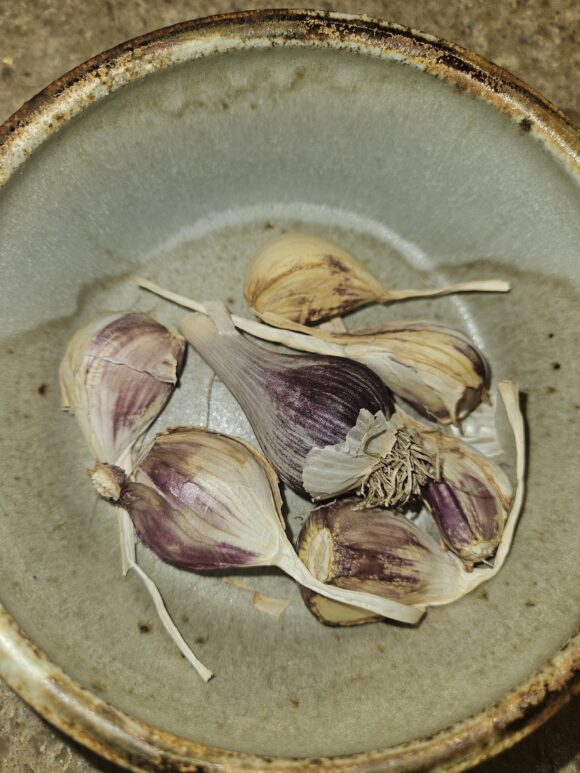(Updated August 2024) This summer has seen a higher incidence of infected garlic than perhaps any year since 2012. Unlike 2012, Plum Creek Garlic has had only a slightly higher Phytoplasma infestation than normal. This is simply a matter of luck and we feel very fortunate. The U. of Minnesota extension has a good summary of this disease which you can find here. See below for more information on this disease and how it’s played out for us over the years.
Here’s a picture of Phytoplasma infected garlic sitting on our kitchen counter waiting to be eaten, no problem. However, we will not plant garlic with this infection.

(Updated July 2021) Unfortunately there have been higher than normal Aster Leafhoppers reported this spring in the upper Midwest and many growers are seeing more Phytoplasma infections in their garlic as a result. Infection rates appear to be much lower than in 2012 but significantly higher than the past 8 years. Infected garlic is fine to eat but will not grow well if planted. It’s likely that germination next spring could be lower since it’s difficult to identify early-stage Phytoplasma infections.
(Updated January 2019) We have seen a handful of Phytoplasma infected bulbs during harvest and cleaning the past five years. We have heard the same from other commercial growers. Sometimes it is easy to see the disease, more often identification is only by smell. We set those aside for eating personally since they taste fine but will not grow for the next season. This disease is clearly around each year but fortunately there have only been very low numbers since summer 2012.
(Updated September 2013) Phytoplasma was NOT a new problem for growers in Minnesota this year. No Aster Leafhoppers were reported and no new disease symptoms were found. Unfortunately most growers that planted their own stock from last year (2012) did have germination problems this year (2013) since the disease does winter over in infected plants. See details below. Any garlic that grew normally this year (2013) is fine for planting. Based on historical records, we are all hoping this disease does not recur for many years. Plum Creek Garlic had a good crop with no disease incidence.
(September 2012) Many garlic growers in the upper Midwest have reported yellowing leaves and premature browning resulting in both crop loss and smaller garlic heads at harvest in 2012. Some growers had 100% crop loss while others have had little or none. Plum Creek Garlic experienced about a 70% crop loss by weight in 2012.
A very small bacteria called Phytoplasma has been identified as the most likely culprit via DNA testing. The specific type of Phytoplasma infecting garlic in Minnesota has a common name of Aster Yellows and is transmitted from plant to plant only by the Aster Leafhopper (Macrosteles quadrilineatus) which carries the disease from infected plants. It is not completely clear why this happened in 2012 although very large Aster Leafhopper infestations in late April and early May 2012 were documented in a University of Minnesota Extension report. One of the authors of this report said they were finding as many as 70 Aster Leafhoppers per square foot in Barley. If you do the math this is over 3,000,000 Aster Leafhoppers per acre! This author thought the warm spring in the south and several large rain events in late April and early May 2012 brought them north in extremely large numbers.
Normally Leafhoppers are not considered a garlic pest and many remedies for Leafhopper problems on vegetables often include garlic as a key ingredient to repel them. Garlic is not a preferred food for this particular Leafhopper but the vast numbers in 2012, combined with a high infection rate and limited alternative food sources early in the spring probably contributed to the problem.
While the garlic cloves themselves are fine and taste great, the wrappers typically have a deep purple or dirty brown color. Aster Yellows infects the growing parts of the plant and does not infect the soil or move through the air.
Reports across the Midwest indicate many crops, flowers and vegetables have been infected by the Phytoplasma disease in 2012. It appears Phytoplasma affected garlic production in Edmonton, Alberta in 1999 and in Argentina garlic a few years earlier than that. Phytoplasma are very common and found in many plant species although the Aster Leafhopper is considered the only insect vector for Aster Yellows which is the specific type that infected garlic in 2012. See the U of Minnesota Extension article for more information on controlling and managing this pest.